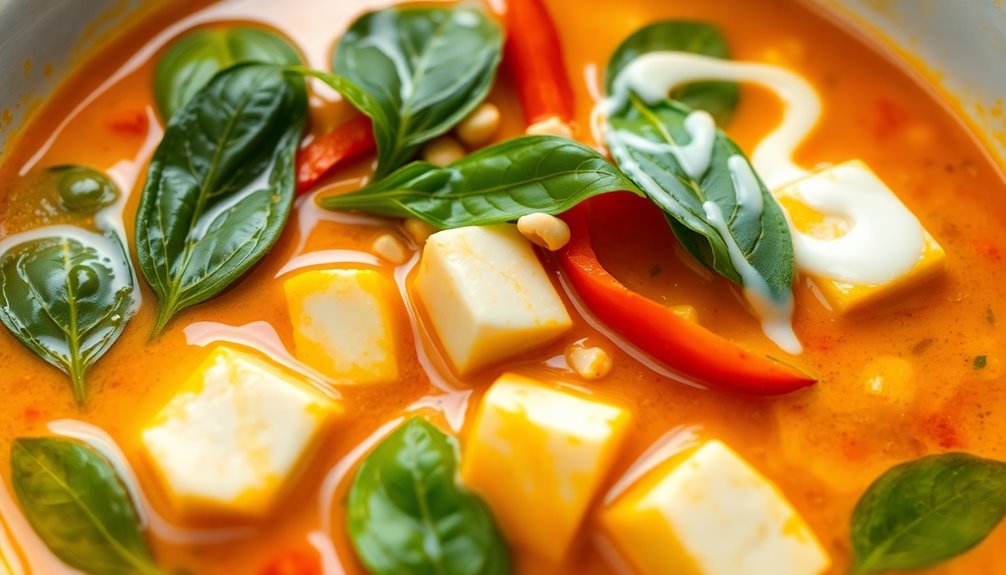You're about to elevate your cooking game with a One-Pot Thai Curry With Tofu. Start by pressing and cubing firm tofu for a dense texture. Sauté onions, garlic, and ginger in oil until fragrant, then stir in your favorite Thai curry paste. Pour in rich coconut milk to create a creamy base, and toss in vibrant vegetables like bell peppers and snap peas. Let it simmer until everything's tender and coated in flavor. Serve over jasmine rice or with a side of naan, garnished with fresh herbs and lime juice for that extra zing. There's so much more to explore!
Key Takeaways
- Start by pressing and marinating firm tofu in soy sauce, lime juice, and maple syrup for enhanced flavor before cooking.
- Sauté onions, garlic, and ginger in oil, then add aromatic vegetables and fresh herbs to build the curry's depth of flavor.
- Stir in Thai red curry paste and coconut milk, allowing the tofu to caramelize for a spicy-sweet, creamy dish.
- Serve the curry over jasmine or coconut rice, garnished with fresh cilantro, lime juice, and toasted nuts for added texture and flavor.
- Opt for locally sourced and organic ingredients to create a sustainable, eco-friendly meal while minimizing food waste.
Ingredients You'll Need
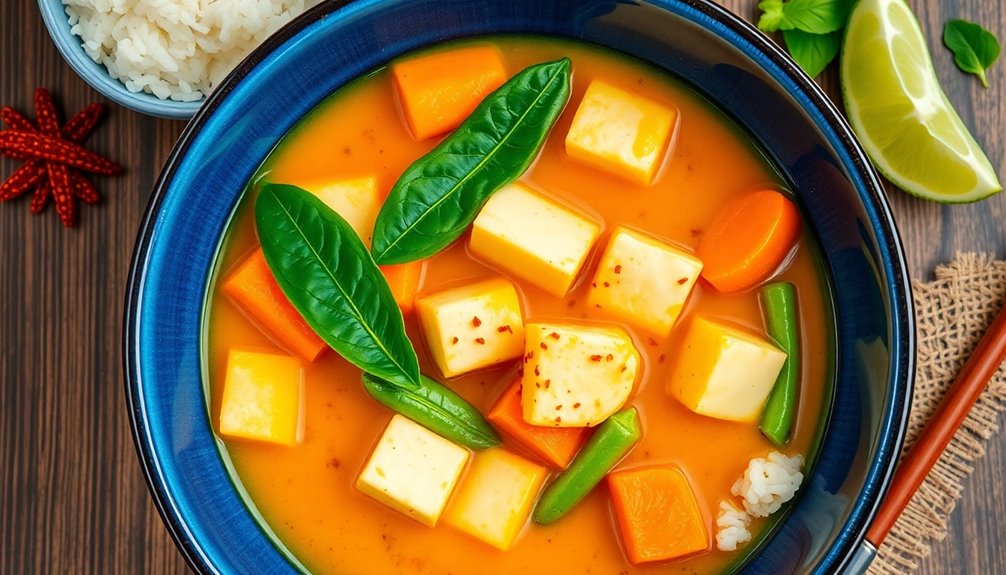
To whip up a delicious one-pot Thai curry with tofu, you'll need a variety of flavorful ingredients that come together to create a vibrant dish. Start with firm tofu, which offers a satisfying density that holds its shape beautifully during cooking.
You'll want to include aromatic vegetables like bell peppers, carrots, and snap peas. These not only add color but also contribute different textures that contrast perfectly with the tofu.
Next, gather essential spices and pastes. Thai red curry paste is the heart of this dish, delivering a punchy flavor profile that's both spicy and sweet. Coconut milk gives your curry a creamy, rich base, balancing the heat with its soothing qualities.
Don't forget fresh herbs like basil and cilantro; they'll elevate the dish with their fragrant notes.
For an added layer of complexity, toss in a splash of soy sauce or tamari to deepen the umami flavor. Lime juice is essential too, providing a bright acidity that ties all the elements together. If you enjoy a bit of heat, consider adding fresh chilies or chili flakes to the mix.
Preparing the Tofu
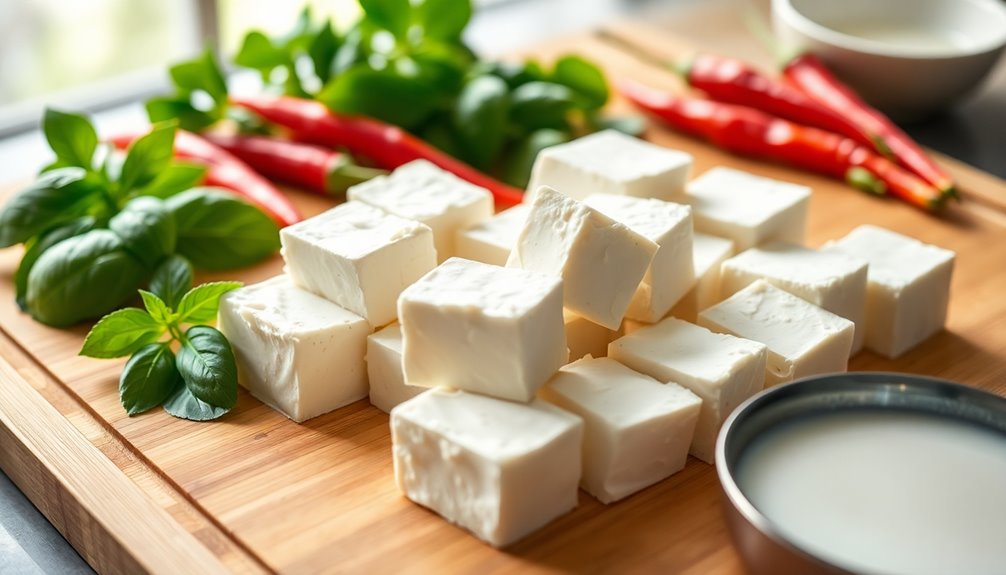
Firm tofu is your best friend when it comes to creating a flavorful base for your Thai curry. Its robust tofu texture holds up beautifully during cooking, absorbing all those aromatic flavors while providing a satisfying bite. Start by pressing your tofu to remove excess moisture, which enhances its capacity to soak up the delectable tofu marinade you're about to craft.
Wrap the tofu block in a clean kitchen towel, place it on a plate, and weigh it down with something heavy for about 15-20 minutes.
Once your tofu is pressed, cut it into bite-sized cubes. This shape guarantees uniform cooking and yields those perfect little nuggets of joy in every spoonful. Now it's time to mix up your marinade. A simple blend of soy sauce, lime juice, and a touch of maple syrup works wonders, infusing the tofu with a harmony of salty, tangy, and slightly sweet flavors. Let the cubes marinate for at least 30 minutes, or longer if you can manage. The longer they sit, the more robust the flavor will be.
As you prepare the tofu, envision how it'll metamorphose into a golden, caramelized delight in your curry. This isn't just food; it's a warm embrace, a way to share love and culture through a dish. You're not just cooking; you're crafting a comforting experience for yourself and those you share it with. So, get ready to relish every bite of your Thai curry adventure!
Cooking the Aromatics
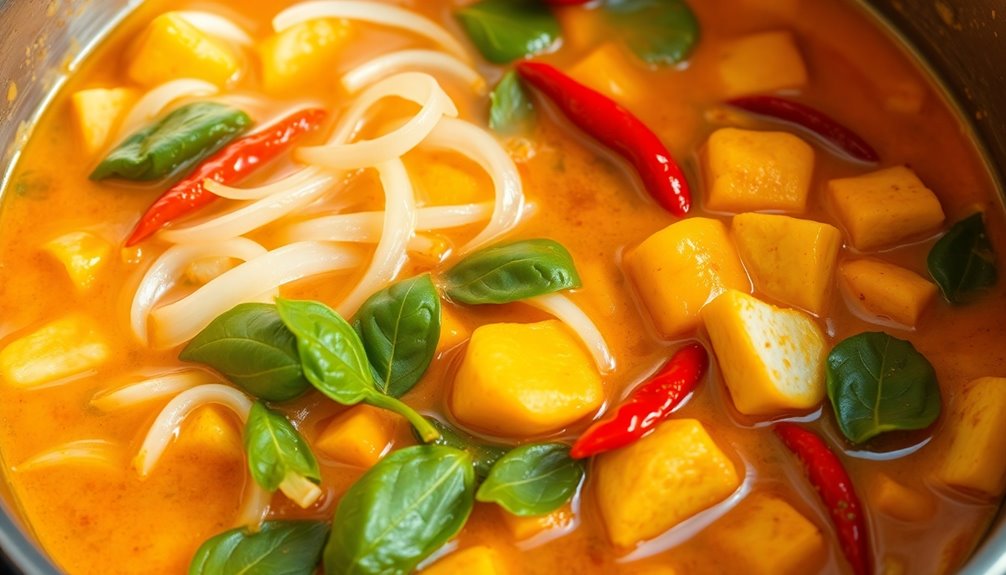
Aromatic components are the heart and soul of your Thai curry, transforming simple elements into a fragrant masterpiece. Start by heating a splash of oil in your pot over medium heat. As it warms, toss in your chopped onions, garlic, and ginger. This trio of fragrant elements lays the foundation for a rich flavor profile, creating an inviting base that sings with warmth and complexity.
Stir the mixture gently, letting the onions soften and turn translucent. This technique, often called sweating, reveals the essential oils in your ingredients, enhancing their natural sweetness. As the fragrances begin to fill your kitchen, you'll feel that sense of belonging—like you're part of a community that celebrates the art of cooking.
Next, add in your fresh herbs like lemongrass and kaffir lime leaves. These components are essential, adding brightness and a zesty kick to your curry. Use a wooden spoon to crush the lemongrass slightly, releasing its fragrant oils. You'll notice how each addition changes the flavor profile, layering depth and intrigue.
Don't rush this step; allow the fragrant components to mingle and bloom together, creating a harmonious blend. As the scents swirl around you, take a moment to appreciate the beauty of these cooking techniques. By the time you're done, you'll have a beautifully aromatic base that sets the stage for your curry, ensuring every bite is a celebration of flavor and warmth. Enjoy this process, and let your kitchen come alive with the spirit of Thai cuisine!
Adding the Curry Paste
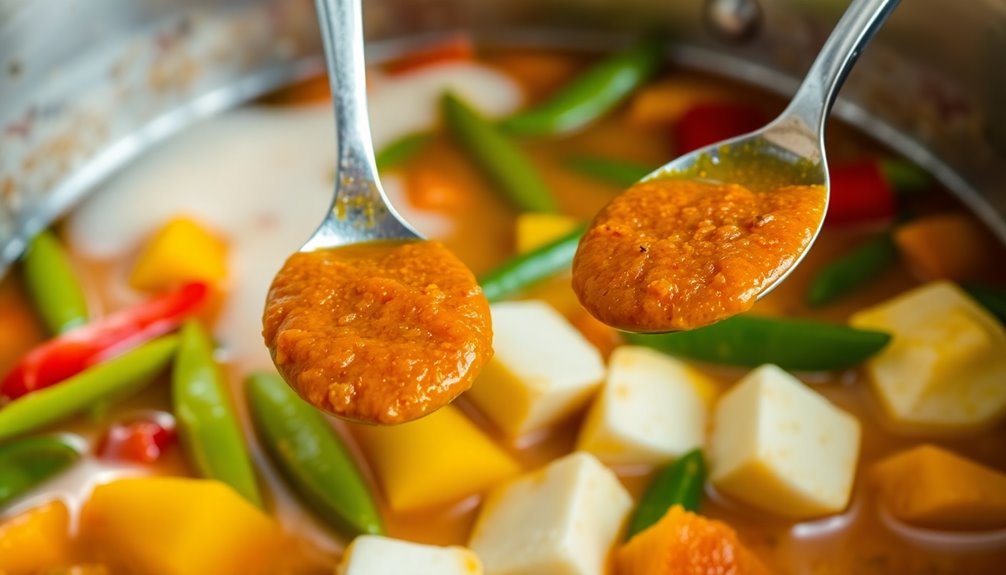
Now that your aromatic base is ready, it's time to elevate your dish by adding the curry paste. This is where the magic happens! Scoop out a generous amount of your chosen curry paste, and watch as it transforms your kitchen into a fragrant haven. Whether you're using red, green, or yellow curry paste, each variety brings its unique flavor variations to the table, so don't hesitate to experiment based on your preferences.
As you add the paste, stir it into the aromatics, letting it sizzle for a moment. This step reveals the essential oils and intensifies the flavors, creating a rich foundation for your curry.
You'll notice the vibrant colors and enticing aromas begin to swirl together, inviting everyone in your home to gather around.
Now, let's talk about choosing the heat. If you like it spicy, opt for a bit more paste or pick a spicier variety. If you're cooking for those with milder tastes, you can adjust the amount to suit their palate. Remember, you can always add more heat later, but it's hard to dial it back once it's in there!
Embrace this opportunity to personalize your curry, making it a reflection of your own taste. The beauty of this dish lies in its adaptability, so don't shy away from experimenting—after all, cooking is about sharing flavors and creating connections.
Incorporating Coconut Milk
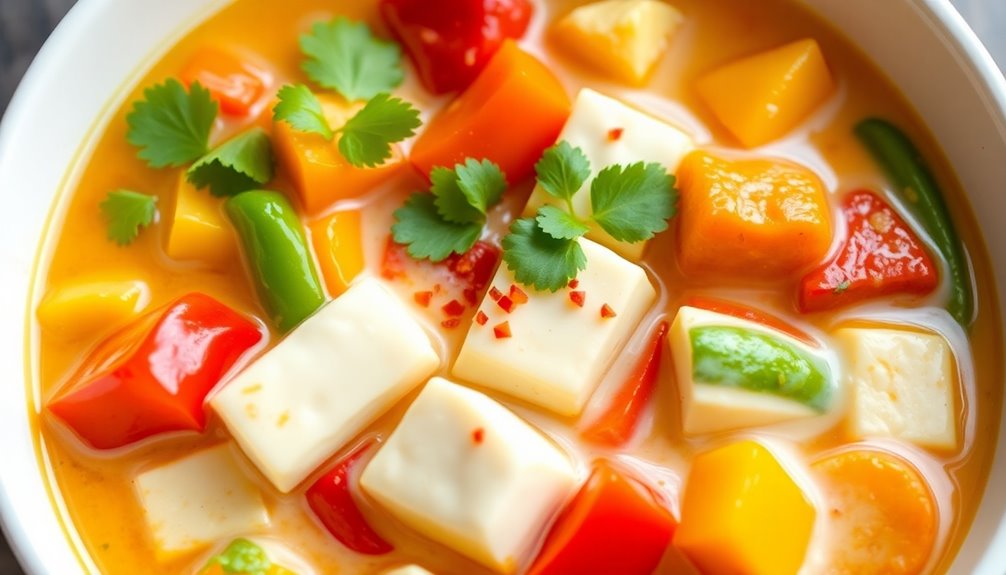
How do you take your Thai curry to the next level? The secret lies in incorporating coconut milk. This creamy, rich ingredient not only enhances the flavor but also brings a velvety texture that elevates your dish. Coconut milk complements the bold spices found in different types of curry flavors, creating a harmonious balance that's absolutely irresistible.
One of the standout benefits of coconut milk is its ability to mellow out the heat from the curry paste while adding a subtle sweetness. This makes it perfect for those who appreciate a little spice but don't want to overwhelm their taste buds. Plus, coconut milk is a fantastic source of healthy fats, providing a nourishing element that rounds out your meal.
When you pour in that luscious coconut milk, watch as it transforms your curry into a comforting bowl of goodness. It beautifully intertwines with the tofu and vegetables, making every bite a delightful experience. You'll find that the creamy consistency not only enhances the flavors but also encourages a sense of belonging as you gather around the table with loved ones, sharing stories and laughter.
Simmering the Vegetables
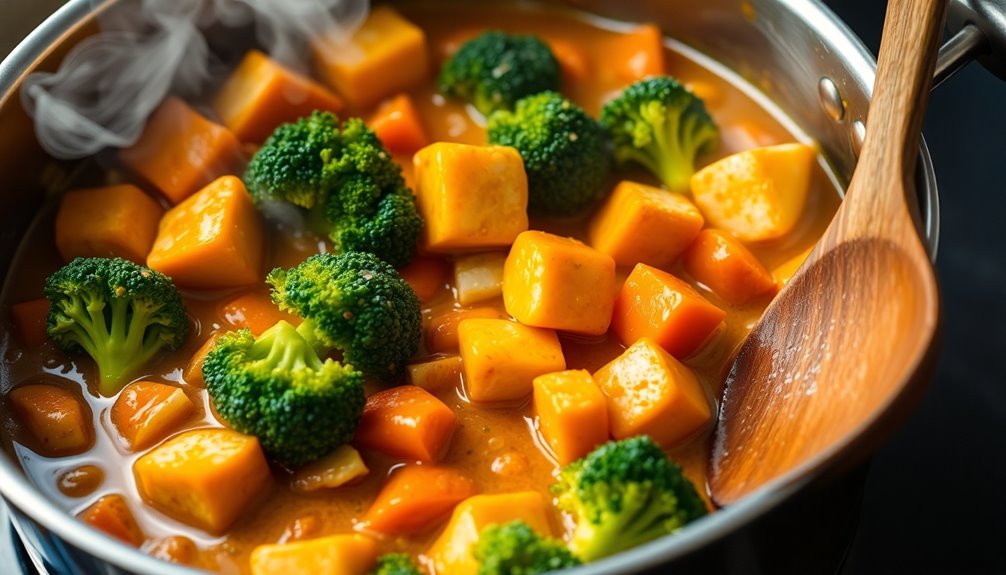
Simmering the vegetables is a crucial step that brings your Thai curry to life. This process not only infuses the dish with rich flavors but also transforms the texture of the vegetables, making them tender and delicious. When it comes to vegetable selection, you'll want to choose a mix of colorful and nutritious options to create a vibrant and hearty dish.
Here's a quick reference for some fantastic vegetable choices:
| Vegetable | Flavor Profile |
|---|---|
| Bell Peppers | Sweet and crunchy |
| Carrots | Earthy and sweet |
| Zucchini | Mild and tender |
| Spinach | Savory and slightly bitter |
Once you've picked your veggies, it's time to master some simmering techniques. Begin by adding your selected vegetables to the pot after incorporating the coconut milk. Bring the mixture to a gentle boil, then reduce the heat to let it simmer. This method allows the flavors to meld beautifully while preserving the vibrant colors and nutrients of the vegetables.
Keep an eye on the simmering time; you don't want to overcook them. Aim for about 10-15 minutes or until they're tender yet still retain a bit of bite. Stir occasionally to ensure uniform cooking and prevent sticking. This step not only enhances the taste but also invites a sense of warmth and comfort, making your curry a loving dish to share with family and friends. Enjoy the process, and savor each moment!
Serving Suggestions
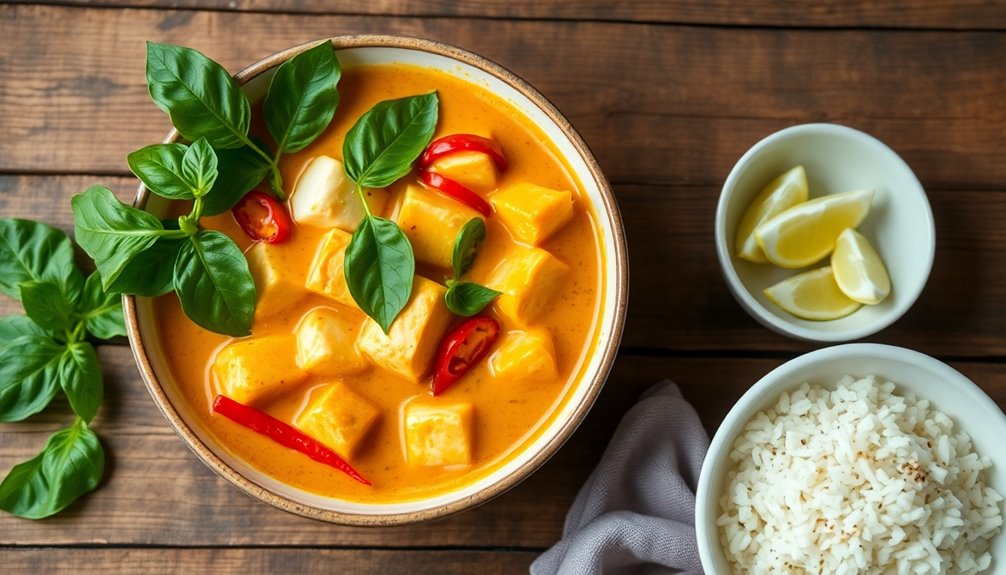
Once your vegetables are perfectly simmered to tender perfection, it's time to think about how to serve your delightful Thai curry. The vibrant colors and rich aromas are sure to impress your family and friends, so let's elevate the experience with some thoughtful pairing options and garnish ideas.
Start by serving your curry over a bed of fluffy jasmine rice or fragrant coconut rice. The subtle sweetness of the rice complements the spiciness of the curry beautifully, creating a balanced plate. If you want to add a twist, consider pairing it with quinoa or even rice noodles for a delightful texture contrast.
Now, let's talk garnishes. A sprinkle of fresh cilantro can brighten the dish and add a burst of flavor, while thinly sliced red chilies can introduce an extra kick for heat lovers. You might also want to squeeze a bit of lime juice over the top, enhancing the curry's flavors with a zesty finish. For added crunch, toasted cashews or peanuts can be sprinkled on for a nutty richness.
Don't forget to serve your curry with some crusty bread or warm naan on the side; it's perfect for sopping up every last drop of that delectable sauce. As you gather around the table, your thoughtfully presented dish will create a warm, inviting atmosphere, making everyone feel right at home. Enjoy the company and the flavors, and you'll create memories that last longer than the meal itself!
Storage Tips

When it comes to storing your delicious Thai curry, a little care goes a long way in preserving its vibrant flavors and textures. To guarantee your dish stays fresh and delightful for later enjoyment, follow these simple storage tips.
First, let your curry cool to room temperature before packing it away. This prevents condensation inside your containers, which can lead to sogginess. Use quality reusable containers to keep your curry sealed and safe. Glass or BPA-free plastic options are ideal for maintaining taste and minimizing environmental impact.
If you've got leftovers or want to prepare in advance, consider freezing tofu. Not only does this help extend the life of your meal, but it also enhances the texture of the tofu, making it even more enjoyable when reheated.
Here's a quick checklist to guide your storage process:
- Cool the curry: Allow it to reach room temperature before storing.
- Use reusable containers: Choose airtight options to maintain freshness.
- Label & date: Clearly mark each container with the contents and date to keep track of freshness.
- Reheat gently: When ready to enjoy, reheat slowly on the stove or in the microwave, adding a splash of coconut milk or broth if needed.
Frequently Asked Questions
Can I Use a Different Type of Protein Instead of Tofu?
Absolutely, you can use different protein alternatives instead of tofu! If you're looking for tofu substitutions, consider chickpeas, tempeh, or even seitan for a hearty texture. Lentils also work wonderfully, adding a unique flavor.
If you prefer meat, chicken or shrimp can easily fit in. Just remember to adjust cooking times to make sure everything's perfectly cooked. Experimenting with these options can make your dish feel fresh and exciting, welcoming everyone to enjoy!
What Is the Best Way to Store Leftovers?
Did you know nearly 40% of food in the U.S. goes to waste? To keep your delicious leftovers, start with proper refrigerator storage. Use airtight containers to maintain freshness and prevent any odor mingling.
If you won't eat them within a few days, consider freezing tips: let them cool completely before sealing, and label with dates for easy access.
This way, you can enjoy your meal and reduce waste, fostering a sense of belonging in sustainability.
How Can I Make the Curry Spicier?
Want to kick up the heat in your curry? Start by adding more chili; fresh or dried, it'll really amp up the spice level.
You might also consider using a spicier curry paste—just a spoonful can transform your dish!
Experiment with different chili varieties to find the perfect balance that suits your taste buds.
Don't be afraid to adjust until it's just right; your curry should reflect your unique flavor journey!
Is There a Gluten-Free Option for This Recipe?
Absolutely, you can create a gluten-free version with some simple ingredient substitutions! Swap out regular soy sauce for tamari, which is gluten-free. Check your broth too, as some brands contain gluten.
For a hearty texture, you can use gluten-free noodles or rice as a base. This way, you'll respect dietary restrictions while enjoying a delicious meal.
You'll feel included and satisfied, knowing you've catered to everyone's needs. Enjoy your cooking!
Can I Freeze This Curry for Later Use?
Did you know that about 40% of cooked food goes to waste? If you're looking to save your delicious curry, freezing it's a great option. Just follow a few freezing tips: cool it completely before transferring to airtight containers.
If you're not keen on tofu, consider chickpeas or tempeh as alternatives. When you reheat, you'll enjoy that comforting flavor again, making it feel like a warm hug on a busy day.
Conclusion
As you savor each spoonful of your one-pot Thai curry, let the vibrant flavors dance on your palate like a warm breeze on a summer's day. The creamy coconut milk and aromatic spices create a comforting embrace, while the tofu and vegetables add heartiness to every bite. Remember, this dish isn't just a meal; it's a celebration of flavors and a canvas for your culinary creativity. Enjoy your creation, and let it transport you to the streets of Thailand with each delightful mouthful.

